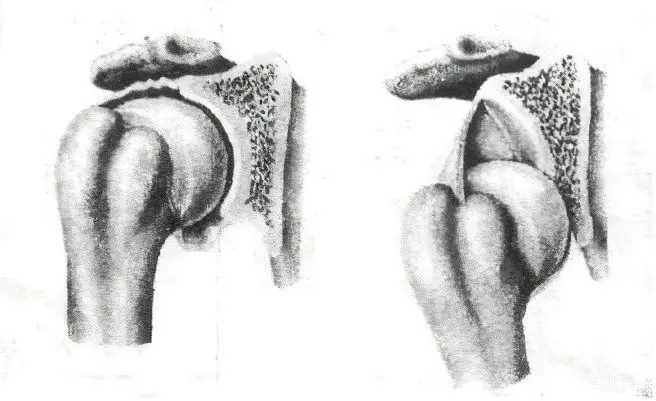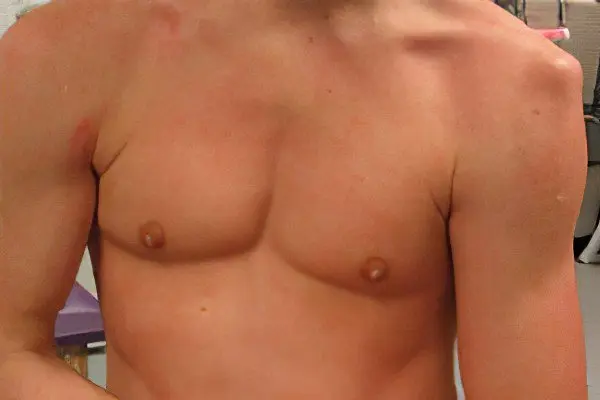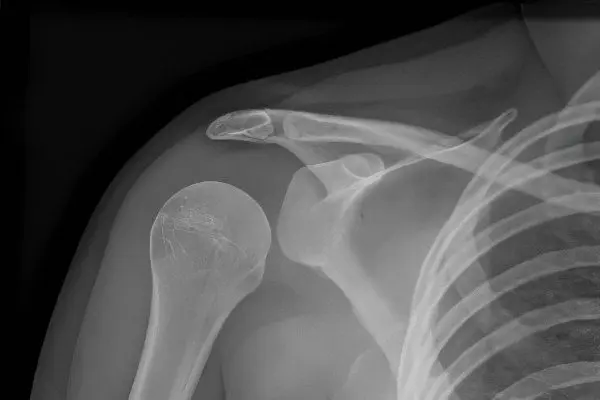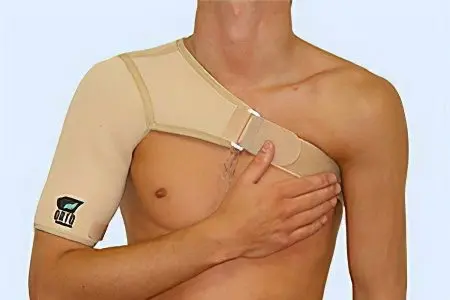Contents
Description and statistics
Among traumatic dislocations, dislocation of the shoulder is the most common. It accounts for about 55% of all injuries. The shoulder joint performs a wide variety of movements, but it is very vulnerable to injury, because the area of contact of its articular surfaces is quite small. For example, most often a dislocation of the shoulder is indirect: a person falls on an arm extended forward or to the side, its movement exceeds the physiological norm, the capsule is torn by the head of the humerus and falls out of the articular cavity.
Rear dislocations are much less common. Statistics attested to approximately 2% of the case. These injuries are formed due to fairly frequent situations when, for example, a fall occurred, but at the same time the arms were extended forward. Then the gap occurs in the back section. There are practically no lower dislocations. This variety differs in that the head of the shoulder bone moves down. With such damage, motor function decreases markedly in the downward direction. Accordingly, there is a need for the victims to keep the injured limb in such a position that the arm is raised, pointing upwards.
There is a risk of re-dislocation. It can occur up to six months after the first one is corrected. Repetitions can happen more than once – up to ten times a year. Each time the changes will increase. This will provoke an increase in the diagnosis of repeated dislocations. Statistics show that such injuries usually occur in people under 20 years of age.
Symptoms of dislocation of the shoulder (shoulder joint)

Symptoms of a dislocated shoulder are the appearance of severe and sharp pain and impaired functioning of the joint. The shoulder or arm is retracted to the side. The shoulder may also harden or become deformed (bent). As a result, the shoulder joints become asymmetrical. When palpated, the head of the shoulder joint is not in its usual place, but below the coracoid process. Joint mobility becomes impossible.
Another symptom is a weakening of the pulse on the radial artery, because the head of the humerus compresses the vascular trunk. Often dislocation of the shoulder is also accompanied by a violation of the sensitivity and motor function of the hand and fingers.
You can learn about the development of the disease by the characteristic symptoms:
Edema, bouts of pain in the corresponding places.
Mobility is noticeably reduced, due to the position of the head described above, the patient can make only a minimum of movements.
The shoulder joint loses its characteristic smoothness of form.
Pain can be observed, which is described as stabbing, the upper limb becomes numb, bruising can reveal lesions, as the blood vessel is damaged, the nerve is in a pinched position.
The sensitivity of such parts of the skeleton as the forearms and other components of the hands disappears.
The condition of the joint capsule noticeably worsens – it loses its density, elasticity, if the disease is not cured immediately. There are changes due to which the volumes of fibrous tissue increase. It begins to fill the articular containing, that is, those areas that are around, are no longer hollow. The stage begins at which the muscle mass ceases to function, that is, it atrophies. There is a dystrophic correction.
There are frequent cases when the first dislocation of the shoulder leads to a rupture of the soft tissues. Then it is accompanied by bouts of noticeable pain. If the dislocation is repeated, the pain is not so strong, or does not appear at all.
Shoulder dislocation can be diagnosed by x-ray (CT or MRI) to differentiate dislocation from a fracture of the proximal end of the humerus or a fracture of the scapula.
As soon as you have identified any of the first symptoms, self-treatment is contraindicated. Usually people try to straighten the joint, but it is very dangerous. Do not take risks, the consequences may be irreparable.
Causes of dislocation of the shoulder joint

We have already mentioned that the shoulder joint is highly mobile. A person most often “wields” precisely this part of the skeleton. It is very vulnerable, and most often it is affected by such a disease as dislocation. Its common cause is the provision of a general force effect, the movement itself is inversion or twisting. To lead to injury, it must be performed with a simultaneous violation of the volume of all possible joint movements.
There are other reasons and factors:
Excess movement directed to this part of the skeleton is diagnosed in 12% of cases, and this type of health disorder is called “joint hypermobility”.
Posterior or anterior varieties appear for various reasons, but most often due to the fact that the glenoid cavity is very tilted.
If the scapular articular cavity has a small capacity, the cause changes noticeably, and the risk factor for dislocation increases.
A common cause is the hypoplasia of the articular cavity, that is, it changes, for the most part, its lower region, and many other changes of a physiological nature also occur.
Often people are forced to repeat the same type of movement, and because of this, the ligaments and the joint capsule are repeatedly stretched. Among the patients, in this case, most often there are athletes (swimmers, handball players, etc.)
A particularly high risk is associated with excessive range of motion. In medicine, this way of movement is called “generalized hypermobility”. There are a number of reasons associated with the anatomical features of the structure of the joint. Then you should conduct research in advance and avoid traumatic situations.
Types of shoulder dislocation
Shoulder dislocations are classified into congenital and acquired. Acquired dislocations, in turn, are divided into traumatic and non-traumatic. Non-traumatic dislocations of the shoulder are arbitrary and pathological (chronic). Traumatic dislocations can be uncomplicated and complicated. Dislocation of the shoulder can be complicated by a violation of the integrity of the skin, tendon rupture, fracture, damage to nerves and blood vessels. Shoulder dislocations are also chronic and pathologically recurring.
Depending on the location of the surfaces of the joints of the humerus and scapula, dislocations of the shoulder are divided into anterior, posterior and lower. Anterior dislocation of the shoulder can be subclavian and subclavian, lower – axillary, and posterior – subacromial and infraspinatus. Anterior dislocations account for the vast majority of shoulder dislocations (about 75%) followed by axillary dislocations (24%). The remaining dislocations account for only 1% of cases.
Dislocations of the shoulder are also classified according to the time elapsed since the injury. They are chronic (the injury was inflicted more than three weeks ago), stale (the time of injury is from three days to three weeks) and fresh (no more than three days).
In addition, dislocation happens:
traumatic (primary);
pathologically chronic.
The cause of the disease is often any movement, even such as cleaning or combing. If the primary dislocation was subjected to improper treatment, or it was not treated at all, complex pathologies of re-dislocation of a traumatic nature develop.
Joint dislocation diagnostics

Dislocation of the joint is diagnosed according to certain indicators. We have already listed many of them among the symptoms. But still, the traumatologist makes a professional examination, drawing a conclusion based on the complaints that he lists.
Other medical examinations are also important. X-ray examination is very effective, for which the method of direct projection or, if necessary, axial technology is used. The quality of the x-ray is sufficient to view the location of the head of the bone, to identify features of its displacement, which also leads to damage to the integrity of the skeleton. The most important task remains to identify what kind of dislocation – anterior or posterior. It is important to identify if there are any fractures.
Therapies
Before the reduction of the shoulder joint, the patient needs anesthesia. Anesthesia can be both general and local. There are many methods for reducing a dislocated shoulder. They are divided into lever, physiological and push (pushing the humerus into the articular cavity). But these methods are often combined with each other.
After repositioning and immobilization of the diseased joint with a plaster splint, its movements should be limited for three weeks. When the splint is removed, it is recommended to undergo a rehabilitation course that restores joint mobility and prevents re-dislocations. The complex of procedures includes massage, therapeutic exercises, electrical muscle stimulation, water exercises, and so on.
Reduction is the basic treatment for shoulder dislocation. It is not produced independently. The only thing the patient can do to cure the disease is to see a doctor as soon as possible. The first dislocations require special attention. They are more difficult, given that it is the first dislocations that are more difficult to reduce.
Treatment of dislocation of the shoulder joint is presented in a wide range.
All methods can be divided into two broad categories:
Non-surgical.
Operating.
The non-surgical or closed method consists in exposure to the head of the humerus. This is done under anesthesia. In this case, it is customary to use a solution of novocaine.
Medical intervention must not be delayed. If it is received out of time, one should expect such consequences as muscle contraction, and this factor greatly complicates the reduction. Then anesthesia is not enough, a number of special preparations will be additionally required, the task of which is to relax the muscles. They are called “muscle relaxants”. If such a measure did not give a result, then the patient will have to prepare for surgery. It is usually an open joint reduction technique.
This is followed by treatment based on the immobilization of the damaged part of the skeleton. This leads to the fusion of torn ligaments and the restoration of the articular lip. This process can occur due to the fact that the articular capsule, going forward, stretches in a peculiar way, which allows you to press the torn off articular lip to the surface of the desired bone. As a rule, plaster bandages are applied at this stage. They should be used for about three weeks.
A dislocated shoulder is treated in a variety of ways, including:
painkillers in the form of tablets or injections necessary to normalize the general condition of the victim, eliminate pain and not only;
anti-inflammatory drugs;
exposure to the injured area with cold, as this reduces pain and swelling.
Physiotherapy
One of the simplest methods of physiotherapy is associated precisely with the application of cold to the affected area. The intensity of pain is noticeably reduced, and inflammation is removed. In the near future after the injury, it is necessary to apply a compress with ice. This reduces the risk of dangerous defects and speeds up recovery.
There is a special complex. Its task is to help create a muscular frame, protect the patient from the development of this disease in the future. If a habitual dislocation of the shoulder joint of a permanent nature is diagnosed, then exercise therapy does not bring positive results. Such a pathology prevents the creation of conditions for further protection of the joint. Good results are obtained by a course of paraffin therapy, electrophoresis, SMT on the area of the affected joint. Not all methods of physiotherapy are relevant in one case or another. For example, patients who have crossed the 70-year milestone require caution. Patients in the elderly category cannot be treated with physiotherapy.
Rehabilitation stages

After a dislocation of the pleural joint, a certain rehabilitation is necessary. It consists of several parts:
includes activation of the functionality of the area of damaged muscles, when the immobilization period begins, the duration of the course is about three weeks;
the functions of the shoulder joint are restored, the duration is approximately three months;
the final steps of the rehabilitation of joint functions, duration – six months.
The bone joint must be immobilized. This requires immobilization. It is the best remedy, and it is used after removing the plaster. Then comes the time of the rehabilitation process, when you need to perform special exercises. They are aimed at using circular movements to produce circular movements with the shoulder. Good results are obtained by exercising in the water.
A disease such as a habitual dislocation of the shoulder requires treatment in certain conditions of a specialized trauma hospital. A measure such as surgical intervention will be required. Here, conservative procedures will not give a positive result. Surgery offers a whole section on the treatment of this pathology. Treatment should be appropriate to the cause of the dislocation of the shoulder joint. Recall that because of this displacement of the head of the humerus can be of different characters.
After the operation, they undergo special rehabilitation. Conducted electrical muscle stimulation, massage and exercise therapy.
When three months pass after the operation, small loads are allowed (for example, after six months, heavy physical labor). Be sure to use a fixing bandage, it is not removed for 1-4 weeks. The time depends on the type of operation performed.
Rehabilitation helps to strengthen the muscles of the shoulder girdle. They begin to grow stronger in terms of a stabilizing effect on the joint. At the first stages, physiotherapy exercises are required, when the supervision of an instructor is necessary. After some time, the patient gets the opportunity to practice at home. This stage can last 2-4 months.









